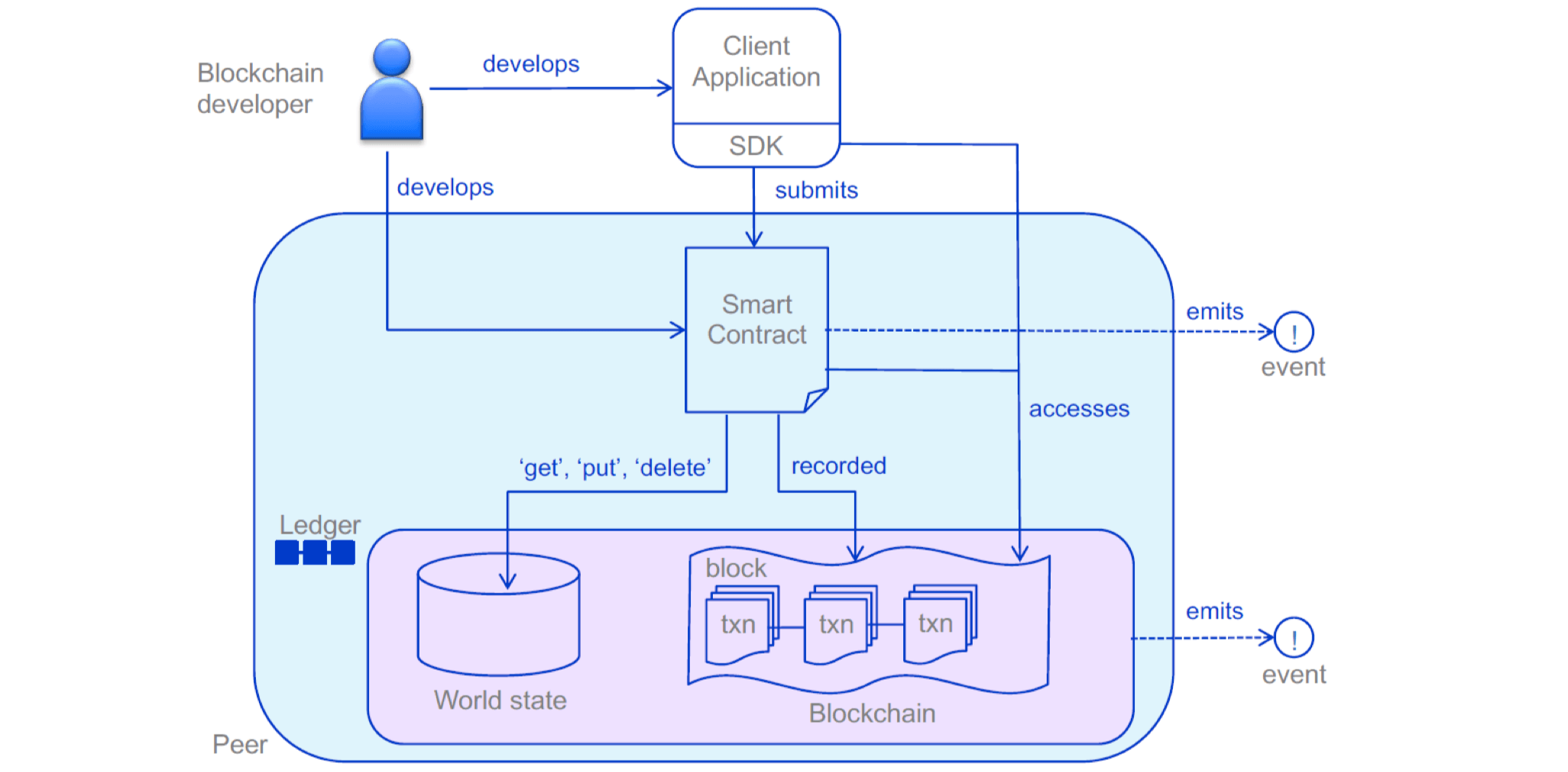前言
最近在做跨链适配器,需要在一条本地链上利用 Go SDK 来连接 fabric 网络,并监听事件,所以对 fabric 所支持的事件与 SDK 所提供的监听方法做一下汇总。
Fabric 事件

事件是客户端与 Fabric 网络进行交互的一种方式,如上图所示,Fabric 网络中执行一个交易后,因为是异步进行的,所以客户端无法获取提交的交易状态(是否被接受),因此,Fabric 的 Peer 节点提供了事件机制,客户端可以通过 gRPC 接口来监听区块事件。从 fabric v1.1 开始,时间的注册发生在通道级别而不是 Peer 节点,因此可以进行更精细的控制
事件类型
事件主要由 Ledger 和存有链码合约的容器触发。Fabric 共支持四种事件形式:
- BlockEvent 监控新增到 fabric 上的块时使用
- ChaincodeEvent 监控链码中发布的事件时使用,也就是用户自定义事件
- TxStatusEvent 监控节点上的交易完成时使用
- FilteredBlockEvent 监控简要的区块信息
在 Fabric Go SDK 中则通过以下几种事件监听器进行操作
func (c *Client) RegisterBlockEvent(filter ...fab.BlockFilter) (fab.Registration, <-chan *fab.BlockEvent, error)func (c *Client) RegisterChaincodeEvent(ccID, eventFilter string) (fab.Registration, <-chan *fab.CCEvent, error)func (c *Client) RegisterFilteredBlockEvent() (fab.Registration, <-chan *fab.FilteredBlockEvent, error)func (c *Client) RegisterTxStatusEvent(txID string) (fab.Registration, <-chan *fab.TxStatusEvent, error)
而当监听完成后需要通过 func (c *Client) Unregister(reg fab.Registration) 来取消注册并移除事件通道
gRPC 通信
SDK 与 Peer 节点通过 gRPC 进行通讯,源码见 fabric-protos/peer/events.proto
其中,定义了以下几种 message:
- FilteredBlock,给 FilteredBlockEvent 使用
- FilteredTransaction 和 FilteredTransaction,给 FilteredTransactionEvent 使用
- FilteredChaincodeAction,给 ChaincodeEvent 使用
- BlockAndPrivateData,给私有数据使用
Response 如下:
// DeliverResponse
message DeliverResponse {
oneof Type {
common.Status status = 1;
common.Block block = 2;
FilteredBlock filtered_block = 3;
BlockAndPrivateData block_and_private_data = 4;
}
}
以及三个 gRPC 通信接口:
service Deliver {
// Deliver first requires an Envelope of type ab.DELIVER_SEEK_INFO with
// Payload data as a marshaled orderer.SeekInfo message,
// then a stream of block replies is received
rpc Deliver (stream common.Envelope) returns (stream DeliverResponse) {
}
// DeliverFiltered first requires an Envelope of type ab.DELIVER_SEEK_INFO with
// Payload data as a marshaled orderer.SeekInfo message,
// then a stream of **filtered** block replies is received
rpc DeliverFiltered (stream common.Envelope) returns (stream DeliverResponse) {
}
// DeliverWithPrivateData first requires an Envelope of type ab.DELIVER_SEEK_INFO with
// Payload data as a marshaled orderer.SeekInfo message,
// then a stream of block and private data replies is received
rpc DeliverWithPrivateData (stream common.Envelope) returns (stream DeliverResponse) {
}
}
整个流程如上图所示,Go SDK 中通过实现一个 Dispatcher 将应用中的事件注册请求转换为事件订阅请求并通过 DeliverClient 发送给 Peer 节点,Peer 节点中的 DeliverServer 接收订阅请求,调用 deliverBlocks 进入循环,从 Ledger 读取区块并生成事件,最后发送给客户端,客户端中的 Dispatcher 又将其转换为应用订阅的事件响应。
事件实现过程
实现时间过程需要两个步骤
- 在链码中调用
SetEvent方法 - 在在客户端中通过 Go SDK 实现事件监听器
SetEvent 方法
方法定义
func (s *ChaincodeStub) SetEvent(name string, payload []byte) error
调用实例
func (s *SmartContract) Invoke(stub shim.ChaincodeStubInterface) sc.Response {
err = stub.PutState(key, value)
if err != nil {
return shim.Error(fmt.Sprintf("unable put state (%s), error: %v", key, err))
}
// Payload 需要转换为字节格式
eventPayload := "Event Information"
payloadAsBytes := []byte(eventPayload)
// SetEvent 方法通常位于 PutState、DelState 等与账本交互的操作之后
err = stub.SetEvent("<事件名称>", payloadAsBytes)
if (eventErr != nil) {
return shim.Error(fmt.Sprintf("事件触发失败"))
}
return shim.Success(nil)
}
客户端事件监听器
// 实现一个链码事件监听
// 传入相应参数,这里的 eventId 必须与链码里的 <事件名称> 匹配以实现监听
reg, eventChannel, err := eventClient.RegisterChaincodeEvent(chaincodeID, eventID)
if err != nil {
log.Fatalf("Failed to regitser block event: %v\n", err)
return
}
// 取消注册并移除事件通道
defer eventClient.Unregister(reg)
总结
以上就是通过 Go SDK 对 fabric 网络上的事件进行监听操作的基本介绍,正在看 fabric Go SDK 源码,后续将补充一些解读。

